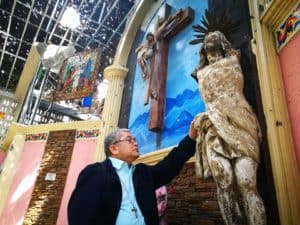In the Philippines, a bishop finds his cathedral destroyed, but keeps hope
IN THE SPRING of 2017, jihadists claiming to be the local branch of ISIS, launched an assault on the city of Marawi, the Philippines. They took control of St. Mary’s Cathedral. The parish priest was held hostage along with a number of cathedral staffers. The priest escaped four months later.

The Filipino army battled the insurgents for nearly five months and the city of 400,000 people—the great majority Muslims—suffered major damage. Three months after the end of the battle, authorities still do not allow access to the city center, which was known as “Ground Zero,” is referred to as the Most Affected Area (MAA)
On Jan. 11, 2018, a small delegation was allowed to visit the MAA. Among the group was Bishop Edwin de la Peña of Marawi, who was able to visit the cathedral for the first time since May 2017. The delegation was the first to enter the area since the war’s conclusion, accompanied by a significant military escort.
As he approached the church, the bishop later confessed, he felt his heart break. The first thing he did was to kneel in silence in front of the devastated altar. Everything has been damaged, including the statues of our Lord and of the Virgin Mary. Bullet holes, burned liturgical furniture, destruction are everywhere. The bishop’s residence, just in front of the cathedral, was totally destroyed.
Nonetheless, the bishop expressed his determination that his priority, rather than the rebuilding of the cathedral, was to ensure the return of the Christian population that had fled the fighting. No need of cathedral if that wasn’t achieved but after the trauma of the war, that goal seemed an incredible challenge.
One of his major reasons for not losing hope is the fact that, among the volunteers working with the Catholic Church to help the people and rebuild trust, there are many young Muslim people. Actually, most of the volunteers are Muslims and they are really engaging with the different programs proposed by the Church.
If this whole nightmare would at least produce a new generation of peace-building volunteer, maybe the possibility of a future remains.
The bishop, the faithful—who before the siege of Marawi City only comprised a minority of 3 percent of the city’s population—and even the volunteers expressed gratitude to Aid to the Church in Need for its support. The bishop and his people have a great responsibility: if they are able to reconcile the Muslim and Christian communities of Marawi City, they can be models for other regions of the world where tension between Muslims and Christians run high.
—Marc Fromager
Mr. Fromager is the director of Aid to the Church in Need-France. He accompanied Bishop de la Peña on his visit to St. Mary’s Cathedral.

